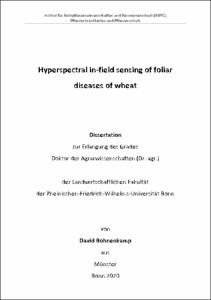Bohnenkamp, David: Hyperspectral in-field sensing of foliar diseases of wheat. - Bonn, 2020. - Dissertation, Rheinische Friedrich-Wilhelms-Universität Bonn.
Online-Ausgabe in bonndoc: https://nbn-resolving.org/urn:nbn:de:hbz:5-60384
Online-Ausgabe in bonndoc: https://nbn-resolving.org/urn:nbn:de:hbz:5-60384
@phdthesis{handle:20.500.11811/8838,
urn: https://nbn-resolving.org/urn:nbn:de:hbz:5-60384,
author = {{David Bohnenkamp}},
title = {Hyperspectral in-field sensing of foliar diseases of wheat},
school = {Rheinische Friedrich-Wilhelms-Universität Bonn},
year = 2020,
month = dec,
note = {The major aim of this work was to prove the suitability of hyperspectral sensors for the detection of foliar diseases of wheat under field conditions. Hyperspectral sensors, measurement protocols and analysis methods were evaluated both under controlled and field conditions. Findings from controlled conditions were used to gain knowledge about the requirements for successful measurement routines using hyperspectral sensors and to transfer this knowledge to field measurements. Therefore, hyperspectral measurements were performed on different scales, under laboratory conditions (measuring distance 11-45 cm) as well as under field conditions using a ground-based vehicle (50 cm) and an unmanned aerial vehicle (UAV drone) (20 m).
Under controlled conditions, the hyperspectral dynamic of five different foliar diseases of wheat was investigated in detail. Certain spectral changes were found to be characteristic for a specific disease and defined as turning points. The turning points of each disease were combined in a spectral library. The spectral library in combination with algorithms from machine learning was successfully used to detect, identify and quantify the diseases on wheat leaves. A spatial referencing method based on a non-linear 2D polynomial transformation model was developed to perform a retrospective analysis of diseased pixels on wheat leaves. By retrospectively going back in time and automatically choosing the same pixels over different measurement days, an earliest detectability test for different diseases was performed. The pure spore spectra of brown rust and yellow rust were used as input data for a least-squares factorization to differentiate between the two diseases by a signal decomposition. The mixed signal of a diseased plant leaf was decomposed, and the presence of pure spore spectra was detected to identify the disease. A deep learning approach using 3D convolutional neural networks was used to perform a disease detection and identification on hyperspectral data without previous data labelling.
The findings from laboratory experiments were used to conceptualize two measurement field platforms. Data preprocessing routines were developed with the purpose to normalize and process the field data. Bringing the data into a comparable form allows to compare the images of one measurement day and on different measurement dates. The data was analyzed using algorithms from machine learning. A feature selection was performed to describe certain wavebands that can be used for yellow rust detection as most significant disease during vegetation period 2018. The classification of yellow rust was successfully performed both on the ground and UAV scale with high classification accuracies. The outcome of this study proved the suitability, and with further improvement of analysis methods, the potential of hyperspectral sensors for an in-field disease detection in winter wheat.},
url = {https://hdl.handle.net/20.500.11811/8838}
}
urn: https://nbn-resolving.org/urn:nbn:de:hbz:5-60384,
author = {{David Bohnenkamp}},
title = {Hyperspectral in-field sensing of foliar diseases of wheat},
school = {Rheinische Friedrich-Wilhelms-Universität Bonn},
year = 2020,
month = dec,
note = {The major aim of this work was to prove the suitability of hyperspectral sensors for the detection of foliar diseases of wheat under field conditions. Hyperspectral sensors, measurement protocols and analysis methods were evaluated both under controlled and field conditions. Findings from controlled conditions were used to gain knowledge about the requirements for successful measurement routines using hyperspectral sensors and to transfer this knowledge to field measurements. Therefore, hyperspectral measurements were performed on different scales, under laboratory conditions (measuring distance 11-45 cm) as well as under field conditions using a ground-based vehicle (50 cm) and an unmanned aerial vehicle (UAV drone) (20 m).
Under controlled conditions, the hyperspectral dynamic of five different foliar diseases of wheat was investigated in detail. Certain spectral changes were found to be characteristic for a specific disease and defined as turning points. The turning points of each disease were combined in a spectral library. The spectral library in combination with algorithms from machine learning was successfully used to detect, identify and quantify the diseases on wheat leaves. A spatial referencing method based on a non-linear 2D polynomial transformation model was developed to perform a retrospective analysis of diseased pixels on wheat leaves. By retrospectively going back in time and automatically choosing the same pixels over different measurement days, an earliest detectability test for different diseases was performed. The pure spore spectra of brown rust and yellow rust were used as input data for a least-squares factorization to differentiate between the two diseases by a signal decomposition. The mixed signal of a diseased plant leaf was decomposed, and the presence of pure spore spectra was detected to identify the disease. A deep learning approach using 3D convolutional neural networks was used to perform a disease detection and identification on hyperspectral data without previous data labelling.
The findings from laboratory experiments were used to conceptualize two measurement field platforms. Data preprocessing routines were developed with the purpose to normalize and process the field data. Bringing the data into a comparable form allows to compare the images of one measurement day and on different measurement dates. The data was analyzed using algorithms from machine learning. A feature selection was performed to describe certain wavebands that can be used for yellow rust detection as most significant disease during vegetation period 2018. The classification of yellow rust was successfully performed both on the ground and UAV scale with high classification accuracies. The outcome of this study proved the suitability, and with further improvement of analysis methods, the potential of hyperspectral sensors for an in-field disease detection in winter wheat.},
url = {https://hdl.handle.net/20.500.11811/8838}
}






